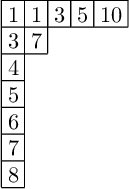CoCalc provides the best real-time collaborative environment for Jupyter Notebooks, LaTeX documents, and SageMath, scalable from individual use to large groups and classes! Also, H100 GPUs starting at $2/hour.
CoCalc provides the best real-time collaborative environment for Jupyter Notebooks, LaTeX documents, and SageMath, scalable from individual use to large groups and classes! Also, H100 GPUs starting at $2/hour.
| Download
Project: Combinatorics classes 2024
Views: 8Visibility: Unlisted (only visible to those who know the link)
Image: ubuntu2204Tableau and Schur polynomials
Math 737 - Lab 5
Evaluate the blocks below to see how to turn an SSYT into a word.

word: 12,12,11,11,2,8,12,12,1,1,3,7
Exercise 1: Use the command below to make an empty SSYT. Then write a 'for' loop to Schensted insert the letters of the word from above one at a time to create a SSYT. Check that this SSYT is the same as the SSYT you found above.
SOLUTION TO EXERCISE 1
----

----

----

----

----
Error in lines 1-4
Traceback (most recent call last):
File "/cocalc/lib/python3.11/site-packages/smc_sagews/sage_server.py", line 1244, in execute
exec(
File "", line 4, in <module>
File "/cocalc/lib/python3.11/site-packages/smc_sagews/sage_salvus.py", line 2972, in show
s = show0(objs, combine_all=True)
^^^^^^^^^^^^^^^^^^^^^^^^^^^^^
File "/cocalc/lib/python3.11/site-packages/smc_sagews/sage_salvus.py", line 2931, in show0
b = show0(a)
^^^^^^^^
File "/cocalc/lib/python3.11/site-packages/smc_sagews/sage_salvus.py", line 2957, in show0
sage.misc.latex.latex.eval(s)
File "/cocalc/lib/python3.11/site-packages/smc_sagews/sage_salvus.py", line 1599, in latex0
sage.misc.latex.Latex.eval(sage.misc.latex.latex, s, **kwds)
File "/ext/sage/10.2/src/sage/misc/latex.py", line 1137, in eval
e = _run_latex_(os.path.join(base, filename + ".tex"),
^^^^^^^^^^^^^^^^^^^^^^^^^^^^^^^^^^^^^^^^^^^^^^^^^^
File "/ext/sage/10.2/src/sage/misc/latex.py", line 821, in _run_latex_
e = subpcall(lt)
^^^^^^^^^^^^
File "/ext/sage/10.2/src/sage/misc/latex.py", line 814, in subpcall
return not call(x, stdout=redirect,
^^^^^^^^^^^^^^^^^^^^^^^^
File "/ext/sage/10.2/local/var/lib/sage/venv-python3.11.1/lib/python3.11/subprocess.py", line 391, in call
return p.wait(timeout=timeout)
^^^^^^^^^^^^^^^^^^^^^^^
File "/ext/sage/10.2/local/var/lib/sage/venv-python3.11.1/lib/python3.11/subprocess.py", line 1262, in wait
return self._wait(timeout=timeout)
^^^^^^^^^^^^^^^^^^^^^^^^^^^
File "/ext/sage/10.2/local/var/lib/sage/venv-python3.11.1/lib/python3.11/subprocess.py", line 1997, in _wait
(pid, sts) = self._try_wait(0)
^^^^^^^^^^^^^^^^^
File "/ext/sage/10.2/local/var/lib/sage/venv-python3.11.1/lib/python3.11/subprocess.py", line 1955, in _try_wait
(pid, sts) = os.waitpid(self.pid, wait_flags)
^^^^^^^^^^^^^^^^^^^^^^^^^^^^^^^^
File "src/cysignals/signals.pyx", line 341, in cysignals.signals.python_check_interrupt
KeyboardInterrupt
Exercise 2: Use the command SemistandardSkewTableaux to create (not print!) the set of skew SSYT shape with and with entries bounded above by 4. How many tableaux are in this set?
Now create the set of skew SSYT of shape with and with entries bounded above by 3. Use a 'for' loop to print this smaller set of SSYT.
(Recall, if you need help, you can type a command followed by ? to see the documentation.)
SOLUTION TO EXERCISE 2
664
Semistandard skew tableaux of shape [4, 4, 2, 1] / [2, 1] and maximum entry 4
Evaluate the cells below to see how to create a specific skew SSYT and rectify it.
Error in lines 2-2
Traceback (most recent call last):
File "/cocalc/lib/python3.11/site-packages/smc_sagews/sage_server.py", line 1244, in execute
exec(
File "", line 1, in <module>
File "/cocalc/lib/python3.11/site-packages/smc_sagews/sage_salvus.py", line 2972, in show
s = show0(objs, combine_all=True)
^^^^^^^^^^^^^^^^^^^^^^^^^^^^^
File "/cocalc/lib/python3.11/site-packages/smc_sagews/sage_salvus.py", line 2931, in show0
b = show0(a)
^^^^^^^^
File "/cocalc/lib/python3.11/site-packages/smc_sagews/sage_salvus.py", line 2957, in show0
sage.misc.latex.latex.eval(s)
File "/cocalc/lib/python3.11/site-packages/smc_sagews/sage_salvus.py", line 1599, in latex0
sage.misc.latex.Latex.eval(sage.misc.latex.latex, s, **kwds)
File "/ext/sage/10.2/src/sage/misc/latex.py", line 1137, in eval
e = _run_latex_(os.path.join(base, filename + ".tex"),
^^^^^^^^^^^^^^^^^^^^^^^^^^^^^^^^^^^^^^^^^^^^^^^^^^
File "/ext/sage/10.2/src/sage/misc/latex.py", line 821, in _run_latex_
e = subpcall(lt)
^^^^^^^^^^^^
File "/ext/sage/10.2/src/sage/misc/latex.py", line 814, in subpcall
return not call(x, stdout=redirect,
^^^^^^^^^^^^^^^^^^^^^^^^
File "/ext/sage/10.2/local/var/lib/sage/venv-python3.11.1/lib/python3.11/subprocess.py", line 391, in call
return p.wait(timeout=timeout)
^^^^^^^^^^^^^^^^^^^^^^^
File "/ext/sage/10.2/local/var/lib/sage/venv-python3.11.1/lib/python3.11/subprocess.py", line 1262, in wait
return self._wait(timeout=timeout)
^^^^^^^^^^^^^^^^^^^^^^^^^^^
File "/ext/sage/10.2/local/var/lib/sage/venv-python3.11.1/lib/python3.11/subprocess.py", line 1997, in _wait
(pid, sts) = self._try_wait(0)
^^^^^^^^^^^^^^^^^
File "/ext/sage/10.2/local/var/lib/sage/venv-python3.11.1/lib/python3.11/subprocess.py", line 1955, in _try_wait
(pid, sts) = os.waitpid(self.pid, wait_flags)
^^^^^^^^^^^^^^^^^^^^^^^^^^^^^^^^
File "src/cysignals/signals.pyx", line 341, in cysignals.signals.python_check_interrupt
KeyboardInterrupt
Error in lines 1-1
Traceback (most recent call last):
File "/cocalc/lib/python3.11/site-packages/smc_sagews/sage_server.py", line 1244, in execute
exec(
File "", line 1, in <module>
File "sage/structure/element.pyx", line 489, in sage.structure.element.Element.__getattr__
return self.getattr_from_category(name)
File "sage/structure/element.pyx", line 502, in sage.structure.element.Element.getattr_from_category
return getattr_from_other_class(self, cls, name)
File "sage/cpython/getattr.pyx", line 357, in sage.cpython.getattr.getattr_from_other_class
raise AttributeError(dummy_error_message)
AttributeError: 'SemistandardTableaux_all_with_category.element_class' object has no attribute 'rectify'
Exercise 3: In Lab 4 (Exercise 3), you learned to multiply SSYT. Do one of these same multiplications another way: Use the above commands to create the appropriate skew SSYT so that rectification of that skew SSYT yields the multiplication of the two tableaux.
SOLUTION TO EXERCISE 3
Evaluate the blocks below to see how to work with the built-in Schur polynomial function in Sage.
Try changing the parameters and to see what this does to the polynomial.
x0^2*x1 + x0*x1^2 + x0^2*x2 + 2*x0*x1*x2 + x1^2*x2 + x0*x2^2 + x1*x2^2
Exercise 4: Use the above code for the Schur polynomial to test an example of the Pieri rule.
First, calculate the two Schur polynomials you are multiplying together on the LHS of the Pieri rule.
Then use the method on partitions add_horizontal_border_strip or add_vertical_border_strip to create all the partitions for the Schur polynomials on the RHS. Calculate these Schur polynomials and add them together.
Check that your computations for the LHS and RHS agree.
[[4, 1], [3, 2], [3, 1, 1], [2, 2, 1]]